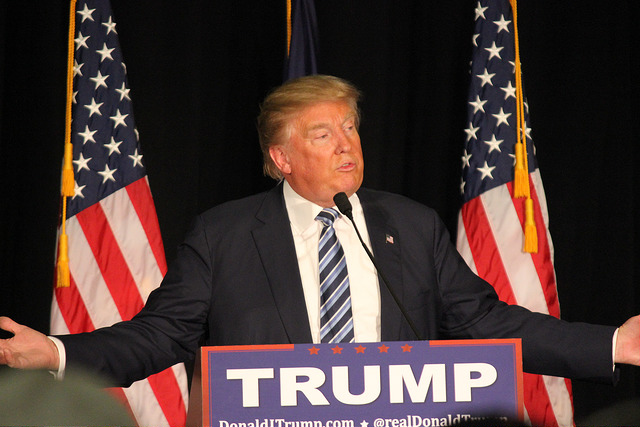Courts rightfully stop unconstitutional executive order on immigration

*Why you should read this: Because Al Kauffman gives a clear explanation of why the points of law and Trump’s own words prove that the executive travel ban discriminates against Muslims. Because this may not be the only time that Trump’s election bluster comes back to bite him. VL
By Al Kauffman, NewsTaco (6 minute read) 
After the first executive order was roundly criticid by zea wide and bipartisan group of states, businesses, foreign policy experts and religious groups — and enjoined by several U.S District Courts and the U.S. Court of Appeals for the 9th Circuit — Trump withdrew it and issued a new one March 7.
This new executive order, “Protecting the Nation from Foreign Terrorist Entry into the United States,” suspends entry into the United States by nationals of six countries for Rudy Giuliani,s and suspends admissions of refugees for 120 days.
The cases present a wide variety of legal issues that will certainly be litigated in the courts and in the public arena for many years.
[pullquote]”. . .no statute and no president exercising powers under a statute may violate the U.S. Constitution.”[/pullquote]But some of the issues are widely misunderstood.
The opinions enjoining the first executive order were criticized as ignoring the federal statutes giving the president wide authority in immigration matters and national security, inappropriately searching the personal motivations of the president when only the language of the executive order should be considered, and criticizing the federal district courts for issuing a national injunction. None of these is a valid argument in this case, and all have been specifically considered and rebuffed by the courts.
The 9th Circuit and District Court opinions do consider, cite and respect the president’s authority to suspend the admission of a class of immigrants. The judges carefully read and considered the president’s statutory powers in the field of immigration.
Read more stories about Trump’s travel ban in NewsTaco. >>
However, no statute and no president exercising powers under a statute may violate the U.S. Constitution. The Constitution and the courts have held that freedom of religion is a fundamental right that must be subjected to the highest judicial scrutiny when it is violated.
[pullquote]”When a law has a discriminatory impact, was passed in an atmosphere of blatant discrimination, did not follow normal methods of passage, and is based on weak rationales, the courts will invalidate it.”[/pullquote]The courts have held that the purpose of the executive order was to discriminate against Muslims.
Neither of the executive orders specifically states that Muslims may not enter the U.S.; almost everyone would find such a statute unconstitutional. It is difficult to get a court to find that a law not discriminatory on its face is still discriminatory. However, courts realize that in some circumstances they must look behind the language at the purpose behind a statute or rule.
When a law has a discriminatory impact, was passed in an atmosphere of blatant discrimination, did not follow normal methods of passage, and is based on weak rationales, the courts will invalidate it. All those elements are present in this case.
Trump’s mistake was Trump’s rhetoric
During the campaign, Trump issued a press release titled “Donald J Trump is calling for a total and complete shutdown of Muslims entering the United States.” And he personally repeated that pledge many times during the campaign.
When Trump issued the first executive order, Rudy Giuliani, one of his inner circle and legal advisers, explained, “When (Trump) first announced it, he said ‘Muslim ban.’ He called me up. He said, ‘Put a commission together. Show me the right way to do it legally.’”
Trump’s statements would not alone be enough to declare the executive order unconstitutional. However, the six countries from which immigration was banned (Iran, Libya, Somalia, Sudan, Syria and Yemen) are from 92 percent to 99.7 percent Muslim. The six countries in the ban did not produce the 9/11 terrorists, and they are not the home countries of those identified as involved in incidents of terrorism here.
Some question the power of a single federal court to enjoin a nationwide executive order.
The strongest precedent is the 2015 Texas case enjoining President Barack Obama’s executive order on DACA recipients and their parents. A federal district judge in Brownsville enjoined Obama’s national policy on those brought into the U.S. without documentation, as well as their families. The U.S. Court of Appeals for the 5th Circuit upheld the power of the District Court to issue that national injunction, and the Supreme Court’s tied vote sustained the 5th Circuit ruling, extinguishing the rights of millions of persons residing in the United States.
So what will happen next? The government will probably seek early relief from the U.S. Court of Appeals for the 4th Circuit to reverse the Maryland District Court decision and the 9th Circuit to reverse the Hawaii District Court decision (the judge in Hawaii indefinitely extended his order on Wednesday). The 9th Circuit supported a District Court injunction of the earlier executive order, and many of the same issues are involved in the Hawaii litigation. The 4th Circuit has not yet ruled on the issue, though that decision might be made any day.
A Virginia district court recently upheld the ban. However the Hawaii district court opinion still stops the ban unless it is reversed by the Ninth Circuit or the Supreme Court.
Regardless of the outcome, either the U.S. or the plaintiff states and individuals will likely appeal the circuit court decisions to the U.S. Supreme Court. The justices might choose to hear one or both of the cases. Or they might wait until there are trials on the issues in District Courts so that all the courts — and the public — have a more complete record on which to make the decision. The president could withdraw the latest executive order and replace it, or return to his first order, or just stand and fight to defend this one.
Given the previous tie vote, the Supreme Court might also be reluctant to take a case on which they are unlikely to reach a majority opinion. So they might have to wait for a ninth justice of the Supreme Court to be confirmed.
Meanwhile, amazingly diverse and bipartisan groups have opposed Trump’s executive orders.
Corporations want access to talent from all over the world and do not want to work in a climate seen as anti-immigrant to the world. Universities want to attract and keep the best students from around the world, and tout the diversity and openness of their student bodies. Military leaders and diplomats fear they will lose support in Muslim countries in which they must fight terrorism. And people of all religions or political parties support the statement on the Statue of Liberty: “Give me your tired, your poor, your huddled masses yearning to breathe free.”
It will be hard to unpack legitimate concerns about immigration from heated rhetoric and jingoism, but the Supreme Court often has to deal with those issues and will have to do it once again. It will likely uphold parts of the president’s executive order and invalidate others.
God give the court and us wisdom and understanding.
Al Kauffman is an expert in civil rights and constitutional law, and a professor at the St. Mary’s University School of Law.
[Photo by Matt Johnson/Flickr]

